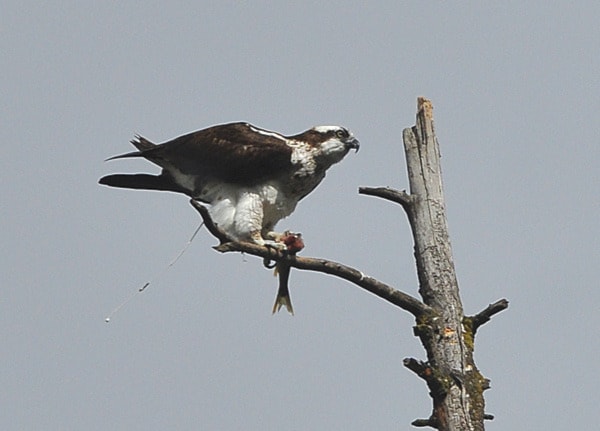The other day I received a phone call from a woman who said she had seen an osprey in a branch of a tree out near Canoe Beach that appeared to have some fishing line wrapped around its legs. She wanted to know if anything could be done to help the bird.
I drove out to search and eventually spotted the poor thing sitting high atop a tree not far from its nest. It did indeed have a length of monofilament fishing line tangled around its legs and talons. I could clearly see several fishing weights still attached to a segment of line dangling from the bird’s feet. It still had a fish in its grasp.
The sad thing is that this sort of situation is preventable.
Far too many anglers head out fishing with line that has been wound around the spool of their reels for years. Monofilament line retains memory, which means the line retains the shape of being tightly wound around the spool. This is more than noticeable when you cast out and the line comes off the reel in spirals. Old line is also brittle and breaks easily.
More often than not, a break occurs as a result of two factors – either because of damage caused by abrasion such as the line rubbing against rocks or downed trees in the water or the line rubbing against the guide at the tip of the rod. It can also occur as a result of poorly tied knots which become a weak point.
Either way, when monofilament fishing line breaks, it leaves a long, spiralling length of line trailing along in the water that can cause great harm to any number of living creatures.
More often than not, the trail of broken line is attached to a hook that has become snagged on a log or branch at the bottom of a lake or stream. Other times, however, as in the case of the osprey out at Canoe Beach, the line is attached to a hook in a fish’s mouth. It is likely the osprey caught the fish and its legs subsequently became entangled in the line.
One way of reducing the amount of line remaining attached to a hook when a break occurs is to tie a swivel the end of your main line and then tie on a short piece of line (about two feet long) of a lighter breaking strength to the other end of the swivel. You can then tie your hook to the end of the lighter line. If you are fishing with 15 pound test line, use a 12 pound test for your short connecting line. A sliding egg weight placed between the swivel and hook will simply slide off if the short line is broken. This way if you do snag up or a large fish happens to break you off, you only lose a short piece of line which will not cause further problems for other living creatures such as waterfowl, kingfishers or birds of prey.
Most hooks are designed to deteriorate fairly rapidly in fish’s mouth and tend to cause little damage. Monofilament line does not deteriorate and can continue to pose a threat for years.
The problem in the situation with the osprey out at Canoe Beach was that, while its legs were entrapped, the bird could still fly.
Any attempt to get close enough to the bird to free it from the fishing line would send it flying off with the line still attached.
Perhaps if it had not been able to fly, it may have been possible to save it. Instead this beautiful bird appears destined to die a slow, cruel death by starvation.
